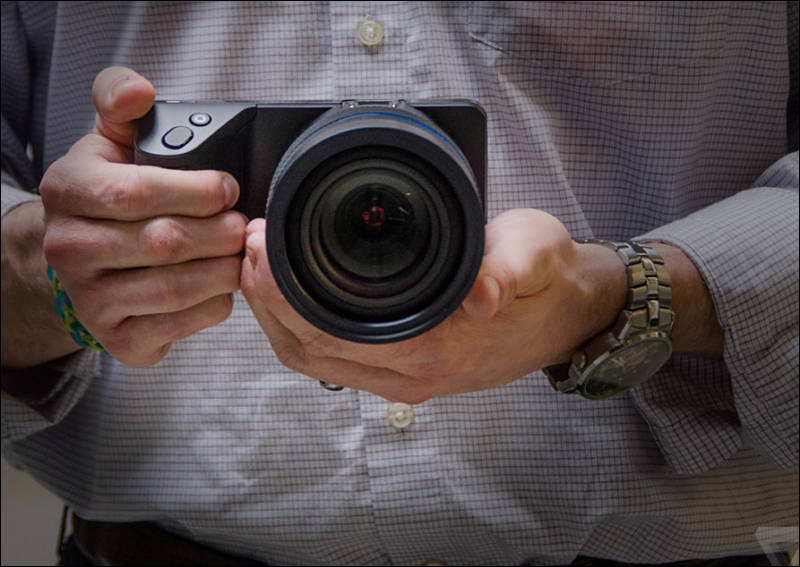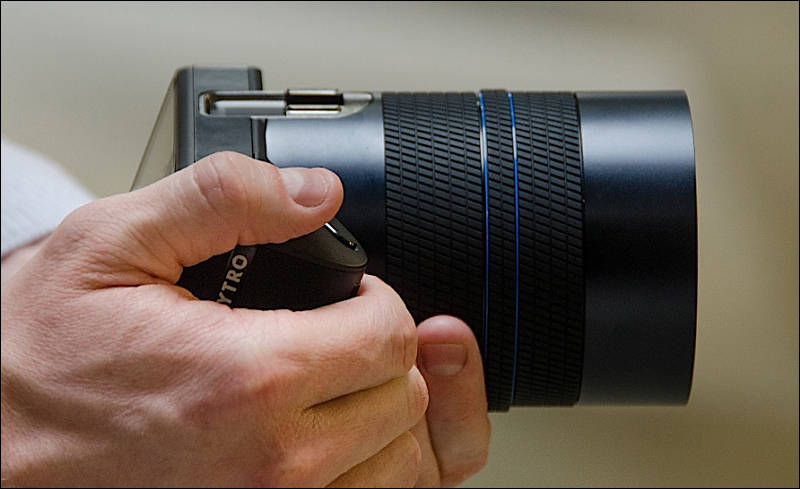
-
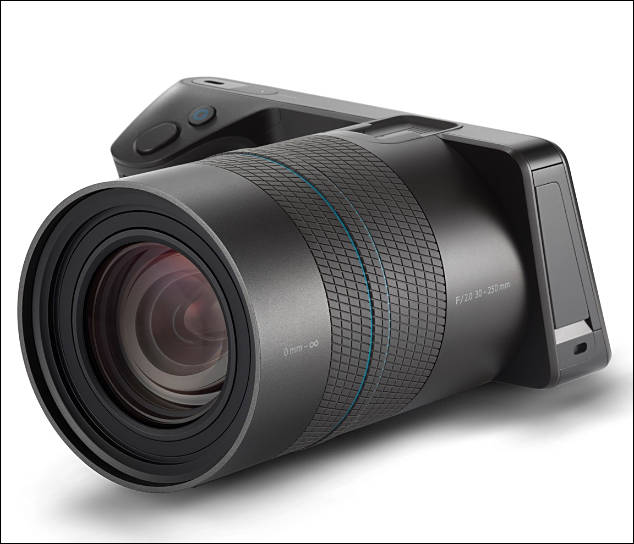
Mountain View, Calif. – (April 22, 2014) – Lytro, Inc. revealed today its powerful vision for the future of photography with the unveiling of LYTRO ILLUM, a light field camera and software platform designed to redefine the way we portray the world around us. Built to harness the full power of the light field, the professional-grade LYTRO ILLUM will give photographers a new medium capable of capturing visual experiences in their purest form — not as a static cross-section of reality but an authentic, interactive window into their world.
The camera paves the way for an immersive brand of storytelling in which images can be brought to life in multiple dimensions through Light Field Photography — a transformative new category that empowers artistic creation and expression beyond what is possible in the 2D world of digital and film. In capturing the color, intensity and direction of every light ray flowing into the camera, LYTRO ILLUM provides a massive amount of visual information that allows photographers to recreate sights and scenes on a truly experiential canvas.
"With LYTRO ILLUM, creative pioneers — ranging from artistic amateurs to experienced professionals — will tap into a new wave of graphical storytelling. Now artist and audience alike can share an equally intimate connection with the imagery, and, in a sense, jointly participate in the magic of its creation," said Lytro CEO Jason Rosenthal. "By combining a novel hardware array with tremendous computational horsepower, this camera opens up unprecedented possibilities to push the boundaries of creativity beyond the limits inherent in digital or film photography."
To enable such rich, layered compositions, LYTRO ILLUM delivers unparalleled optical versatility by merging custom-built hardware with a powerful software platform. The camera offers a 40-megaray light field sensor, 8x optical zoom range, constant f/2.0 aperture and a high-speed shutter capable of freezing motion under a wide variety of conditions. After image capture, the innovative software platform empowers photographers to adjust aspects of images that were previously fixed, such as focus, tilt, perspective shift and depth of field, which allows the photographer to create images that will resonate for the viewer not just in one dimension, but in every dimension.
"My photography style pushes me to look for ways to tell a more compelling story with every image. LYTRO ILLUM gave me that ability by incorporating an interactive element that captures different visual touch points at every depth," said Kyle Thompson, a Chicago-based photographer known for his surreal conceptual style and one of the early users of the camera. "With LYTRO ILLUM, I've been able to make a multi-dimensional image with more perspectives to explore."
LYTRO ILLUM's totally unique photographic experience reflects the technological revolution around virtual reality and 3D graphics as powerful new storytelling formats in the Digital Age. In the hands of creative pioneers, the camera is a catalyst for a transformational shift in which the world will increasingly look for opportunities to craft a more immersive artistic experience.
"Light Field Photography is following the classic pattern for a transformational concept," said Lytro founder Dr. Ren Ng. "The original Lytro camera, which launched in 2012, introduced an entirely new era in photography. LYTRO ILLUM will advance this movement to a new level. We are very excited by the potential of this camera to ignite a photography revolution on the magnitude of the transformation from film to digital."
In addition to enabling post-capture image adjustments, LYTRO ILLUM's proprietary software platform enables users to view images in 3D, build custom animations, export images into common formats like JPEG and share to the Web or mobile devices. LYTRO ILLUM's workflow is also compatible with existing photo-editing suites like Adobe's Photoshop and Lightroom software and Apple's Aperture software, allowing creative pioneers to use the tools they already know and love.
LYTRO ILLUM Availability
The LYTRO ILLUM camera will ship starting July 2014 for a retail price of $1,599.
As part of the launch, Lytro is offering a variety of exclusive opportunities to those who pre-order the camera before July 15. In addition to receiving a specially- engraved LYTRO ILLUM for a special introductory price of $1,499 and an extended two-year warranty, they'll be eligible to join an inner circle of Lytro users with insider access to product development insight and support. Even after the product ships, this nucleus of early adopters will continue to receive ground-floor insight and training from the Lytro team, with opportunities to contribute to exclusive developmental projects.
As part of their status as early adopters, individuals who pre-order will have the opportunity to submit their own photo series to earn a spot in the Ultimate Lytro Photo Experience — a once-in-a-lifetime trip to shoot alongside a prominent photographer on an all-expense paid photo shoot. The Lytro team and this pro photographer partner will be on hand to provide high-caliber, hands-on training and practice for getting the most out of LYTRO ILLUM. As the larger photography community gets acquainted with this new style of digital art, these early adopters will have an inside edge on techniques for producing cutting-edge Light Field Photography.
For more information about LYTRO ILLUM, please visit http://Lytro.com/camera. For a demonstration of interactive living pictures, visit the Lytro Picture Gallery here.
LYTRO ILLUM Technical specs
- Custom-designed 40-megaray light field sensor
- 8x optical zoom lens (30mm-250mm equivalent)
- Constant f/2.0 aperture across the entire zoom range
- 1/4000 of a second high-speed shutter
- Extreme close-focus macro capability
- Combination of tactile-controls and smartphone-class, articulating touchscreen
- Dimensions: 86mm x 145mm x 166mm; 940 grams
- Hot shoe supports all leading flashes
Software Platform
- Integrated workflow with leading photo software from Adobe and Apple
- Interactive depth feedback display
- Virtual camera controls in post-processing, including aperture focus and perspective adjustments and physically accurate tilt control
- Instantly displays 3D photos on 3D-capable devices
- Integrated sharing to leading social networks including Facebook, Twitter, Pinterest, and Google+
- Library of drag-and-drop cinematic animations,including pan,zoom,focus, perspective shift
- Adobe's Photoshop and Lightroom software and Apple's Aperture software compatible
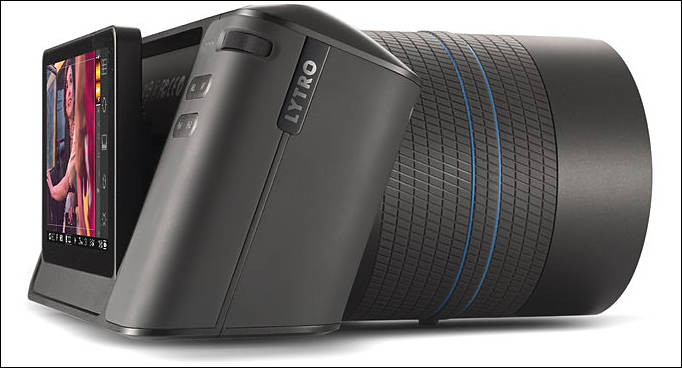
-
I think it's pretty novel using the information they capture from the light to correct for things like chromatic aberrations. This allows them to design impressive lens' designs without the complexity of corrective elements (constant f2 lens is pretty impressive for a 1" sensor).
I'm hoping the next generation has an interchangable lens mount (maybe m43), 80megawhatevers (8MP actual output), and can do 4k video preserving the depth data :) Post focus pulling!
-
Want to upset you slightly.
Previous sensor had 11MRays, and had resolution - 512x512 pixels, 262 144.
With 40MRays it'll be actual 1Mpix :-) or 1024x1024 without interpolation. I think they use smarter algos this time, plus interpolation, as usual.
-
@Vitaliy_Kiselev Darn, thanks for the heads up. I was wondering why the sample was so soft!
So I guess I'm hoping for a 320 megathingamagigs.
I should mention though, the interpolation is pretty good, looks fairly organic or "filmic". Makes sense since they have more data to work with. Kind of neat.
-
Like manna from heaven for rack-focus junkies. But beyond that?
-
I love it. Won't buy it, but love the results.
-
I'm still hoping for a version capable of 1080p video at some point. No need to do the processing in-camera. Just capture all of the raw data and let me run an application on a computer later where I can use a powerful Intel processor with a massive GPU.
-
"Give me a hard copy right there."
Someone had to say it ;)
-
And his machine didn't even have a flat screen…
-
If it'll drop in price a little and they will improve all software it can be almost ideal camera for budget wedding guys.
-
Given how little resolution this camera has, I cannot see anything but a party gag in this, still.
But it's not only the resolution that sucks: Have a look at the picture with the surfer and the white flower in front: Not only are there lots of "stair steps" visible on the outlines of the objects, also there are strange looking artefacts on the leaves of the flower and last but not least the colors look just awful.
I'll buy a GH4 for the same price... :-)
-
Every once in a while, the Lytro Illum blew my mind. I’d take just the right picture at just the right moment, and I’d suddenly have it captured in a way that felt more real, more alive than anything else I could’ve done. For every one of those moments, though, there were three or four moments where I felt like I missed it
http://www.theverge.com/2014/7/30/5949913/lytro-illum-review
-
wasn’t until I brought the Illum to a concert at Brooklyn Bowl that I realized just how quickly I’d bumped into the ceiling of its capabilities. The camera has an ISO range that stretches up to 3200, but images start to break apart with noise at about 1600. The constant-aperture f/2 lens, which is admittedly really nice, is front-heavy and has no image stabilization, so it is hard to keep steady when zoomed all the way to 250mm. You can change the white balance, but only to other presets like "Tungsten" or "Daylight," and the Auto White Balance (the setting I typically use when shooting concerts on my 5D Mark II) is too slow to keep up with the constantly shifting lights of a venue.
http://www.theverge.com/2014/8/1/5956441/what-i-learned-shooting-with-the-lytro-illum
-
They have iOS app now
Lytro Mobile App - https://itunes.apple.com/us/app/lytro-mobile-app/id894109160?mt=8
-
This doesn't do video does it... :-( Couldn't they just go the whole hog of 21st Century science fiction and do away with taking 'still' photos and simply do the new 'extract from raw video' thing that the GH4 will have soon?
-
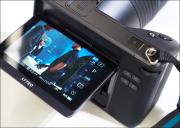
 photokina38.jpg800 x 569 - 61K
photokina38.jpg800 x 569 - 61K -
It is in stock now
-
The Illum has an interesting and very modern design. The camera is actually quite large and heavy (almost 1kg). The body feels solid and is made of magnesium and aluminium, and the grip on the lens ring is also very nice thanks to the “tyre-like” rubber that covers the rings. One thing I don’t like is the smoothness of the zoom and focus ring, as they can shift with the mere brush of your fingers.
-
I rented one a few weeks back. It's a tricky camera to maximize its potential. I still haven't tweaked all of the images since their software is crashing and I haven't had time to troubleshoot.
Watch their tutorial vids, it helps a lot. You really need a close object to focus on to get a good "living pic". Each shot takes quite a bit of thought. You have to think different.
I will definitely rent one again, but won't buy until the next version up.
Howdy, Stranger!
It looks like you're new here. If you want to get involved, click one of these buttons!
Categories
- Topics List23,993
- Blog5,725
- General and News1,354
- Hacks and Patches1,153
- ↳ Top Settings33
- ↳ Beginners256
- ↳ Archives402
- ↳ Hacks News and Development56
- Cameras2,368
- ↳ Panasonic995
- ↳ Canon118
- ↳ Sony156
- ↳ Nikon96
- ↳ Pentax and Samsung70
- ↳ Olympus and Fujifilm102
- ↳ Compacts and Camcorders300
- ↳ Smartphones for video97
- ↳ Pro Video Cameras191
- ↳ BlackMagic and other raw cameras116
- Skill1,960
- ↳ Business and distribution66
- ↳ Preparation, scripts and legal38
- ↳ Art149
- ↳ Import, Convert, Exporting291
- ↳ Editors191
- ↳ Effects and stunts115
- ↳ Color grading197
- ↳ Sound and Music280
- ↳ Lighting96
- ↳ Software and storage tips266
- Gear5,420
- ↳ Filters, Adapters, Matte boxes344
- ↳ Lenses1,582
- ↳ Follow focus and gears93
- ↳ Sound499
- ↳ Lighting gear314
- ↳ Camera movement230
- ↳ Gimbals and copters302
- ↳ Rigs and related stuff273
- ↳ Power solutions83
- ↳ Monitors and viewfinders340
- ↳ Tripods and fluid heads139
- ↳ Storage286
- ↳ Computers and studio gear560
- ↳ VR and 3D248
- Showcase1,859
- Marketplace2,834
- Offtopic1,320


